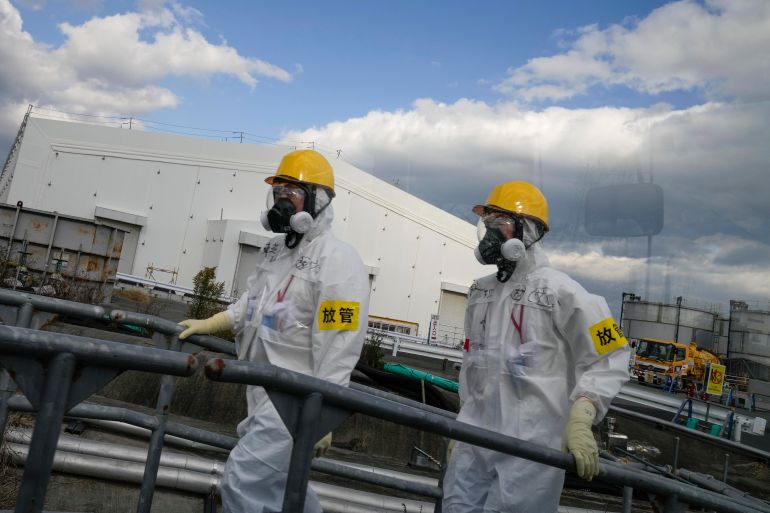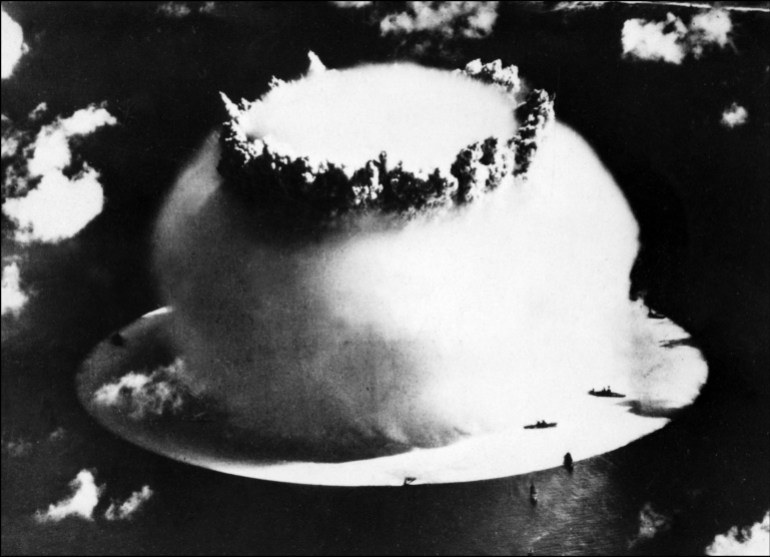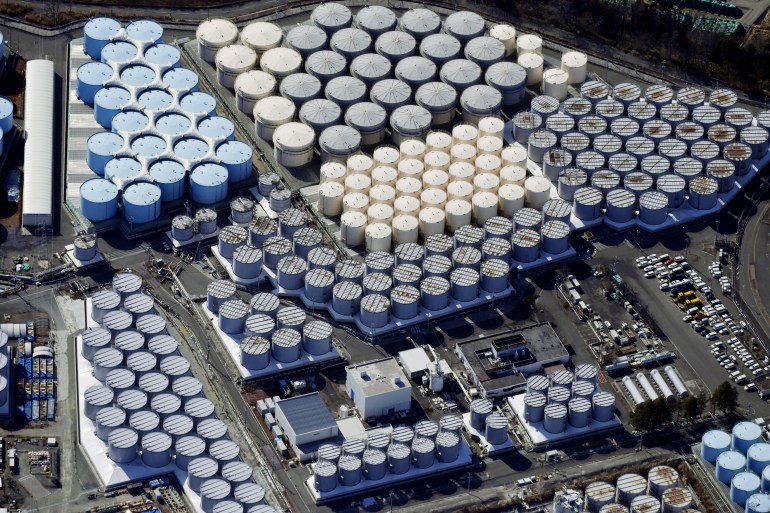‘Not a dumping ground’: Pacific condemns Fukushima water plan
Northern Mariana Islands says proposal for wastewater from stricken plant to be stored on site must be considered urgently.

The Commonwealth of the Northern Mariana Islands says there is a viable alternative to Japan’s plan to dump more than 1 million tonnes of treated water from the crippled Fukushima nuclear power station into the Pacific Ocean, and it requires urgent consideration.
The wastewater is a product of efforts to cool the nuclear reactors at Fukushima that were badly damaged in the March 2011 earthquake and tsunami.
Keep reading
list of 4 itemsUS backs Japan’s Fukushima plans despite S Korea’s concerns
S Korea aims to fight Japan’s Fukushima decision at tribunal
Japan to release contaminated Fukushima water into sea
The Northern Mariana Islands, a United States territory with a population of about 51,659 people, is located only 2,500km (1,553 miles) southeast of Japan. The islands’ leaders have declared that Japan’s plan, officially announced last year, is unacceptable.
“The expectation is that the discharge will not happen until 2023. There is time to overturn this decision,” Sheila J Babauta, a member of the Northern Mariana Islands’s House of Representatives, told Al Jazeera in an interview last month. In December, its government adopted a joint resolution opposing any nation’s decision to dispose of nuclear waste in the Pacific Ocean.
“The effort that went into the creation of the joint resolution exposed research and reports from Greenpeace East Asia highlighting alternatives for the storage of Japan’s nuclear waste, including the only acceptable option, long-term storage and processing using the best technology available,” Babauta said.
Currently, Japan intends to dispose of all the wastewater, which will be treated, over a period of about 30 years.
Anxiety is high among local Japanese fishers and coastal communities. And its plan has met with vocal opposition from neighbouring countries, including China, South Korea and Taiwan, as well as Pacific Island countries and the Pacific Islands Forum, the intergovernmental organisation for the region.
“This water adds to the already nuclear polluted ocean. This threatens the lives and livelihoods of islanders heavily reliant on marine resources. These include inshore fisheries as well as pelagic fishes such as tuna. The former provides daily sustenance and food security, and the latter much needed foreign exchange via fishing licences for distant water fishing nation fleets,” Vijay Naidu, adjunct professor at the School of Law and Social Sciences at the University of the South Pacific in Fiji, told Al Jazeera.
It was the use of the Pacific Islands for nuclear weapons testing by the US, the United Kingdom and France from the 1940s to late last century which has driven heated opposition among islanders to any nuclear-related activities in the region.

Radioactive contamination from more than 300 atmospheric and underwater nuclear tests rendered many locations, especially in the Republic of the Marshall Islands and French Polynesia, uninhabitable and led to irreversible long-term health disorders in affected communities.
Satyendra Prasad, the Chair of Pacific Islands Forum Ambassadors at the United Nations, reminded the world in September last year of the Pacific’s “ongoing struggle with the legacy of nuclear testing from the transboundary contamination of homes and habitats to higher numbers of birth defects and cancers”.
In 1985, regional leaders established the South Pacific Nuclear Free Zone Treaty, prohibiting the testing and use of nuclear explosive devices and the dumping of radioactive wastes in the sea by member states, including Australia, New Zealand and Pacific Island nations.
“For us in the Pacific, the Pacific Ocean has become a proving ground, a theatre of war, a highway for nuclear submarines and waste. The Pacific is not a dumping ground for radioactive waste water,” Maureen Penjueli, Co-ordinator of the Pacific Network on Globalisation, added.
Running out of space
When the earthquake and tsunami struck the Fukushima power plant, three nuclear reactors went into meltdown.
The process of decommissioning the disaster-hit site, which could take up to four decades, includes pumping cooling water through the affected infrastructure to prevent overheating. About 170 cubic metres of treated wastewater is accumulating every day and now fills at least 1,000 tanks around the site.
The Japanese government says it needs to release the water because it is running out of space to store it all.
It says it consulted with other countries in the region after announcing its plan in April last year, conducting briefings with Pacific Island Forum countries and the organisation’s secretariat. It adds that it will cooperate with the international community and adhere to relevant international standards.
“In November last year, experts from laboratories of the IAEA [International Atomic Energy Agency], France, Germany, and the Republic of Korea visited Japan to collect samples such as fish. These samples will be divided and sent to these laboratories for analysis,” a spokesperson for Japan’s Ministry of Foreign Affairs told Al Jazeera.
“The sea area monitoring will be strengthened from one year before the discharge, which is expected to start in spring 2022 under the current plan. The concentration measurement of the nuclides regulated by law, including tritium and carbon-14, will be measured prior to the discharge into the sea, and reports of the results will be made public.”
Last year, Rafael Mariano Grossi, the director-general of the IAEA, expressed support for Japan’s decision.
“We will work closely with Japan before, during and after the discharge of the water,” Grossi said. “Our co-operation and our presence will help build confidence, in Japan and beyond, that the water disposal is carried out without an adverse impact on human health and the environment.”
The US has also given its backing to Japan.
Babauta believes storage space is available at the Fukushima Daiichi site and on nearby land in Japan’s Futaba and Okuma districts.
In a report published in 2020, Greenpeace argued that “the only acceptable solution” was for Japan to continue the long term storage and processing of the contaminated water.
“This is logistically possible and it will allow time for more efficient processing technology to be deployed as well as allowing the threat from radioactive tritium to diminish naturally,” the environmental group said. Greenpeace said that while the Japanese government had considered allocating land for storage in Okuma and Futaba, ocean discharge was seen as easier and less time-consuming.
The wastewater storage option is also favoured by the expert civil society organisation, the Citizens Committee on Nuclear Energy (CCNE), which is supported by Tilman Ruff, associate professor at the Institute for Global Health at the University of Melbourne in Australia.
“Their [CCNE’s] recommendation for the management of the water is that, the first thing to do would be to store it in properly built secure long-lived large tanks similar to the ones that Japan uses for its national oil and petroleum reserves … The argument that they make, which, I think, is really very valid, is that, if this water was stored not for an indeterminant period, but even for a period of about 50-60 years, then, by then, the tritium will have decayed to a tiny fraction of what it is today and hardly be an issue,” Ruff told Al Jazeera.

The Japanese government insists the effect of the radiation on human health as a result of the discharge is small, specifying that it will amount to 0.00081 mSv/year (millisievert of radiation per year), a fraction of the natural radiation exposure level, estimated at 2.1 mSv/year. But medical experts have serious concerns about the enormous volume of wastewater and the potential fallout of even minimal amounts of Tritium, a radioactive isotope that will not be removed during treatment.
“Tritium is a normal contaminant from the discharges, the cooling water from normal reactor operations, but this is the equivalent of several centuries worth of normal production of tritium that’s in this water, so it is a very large amount,” Ruff said.
“The government says that it will dilute the water so that it doesn’t exceed the concentration limits that are regulated … It might allow you to tick a regulatory requirement, but it doesn’t actually reduce the amount of radioactivity going into the environment and the amount of radioactivity that is being released here is really critical,” added Ruff, who is a Nobel laureate and co-president of the International Physicians for the Prevention of Nuclear War.
He says that the human and environmental consequences of even very low levels of radiation exposure cannot be discounted.
“Obviously, the higher the level of exposure [to radiation], the greater the risk, but there is no level below which there is no effect,” Ruff said. “That is now really fairly conclusively proven, because in the last decade or so there have been impressive very large studies of large numbers of people exposed to low doses of radiation. At levels even a fraction of those that we receive from normal background [radiation] exposure from the rocks, from cosmic radiation. At even those very low levels, harmful effects have been demonstrated.”
For Babauta and other Pacific Islanders, any effect is untenable.
For now, she says that it is vital that the Northern Mariana Islands have “a seat at the decision-making table. Major decisions such as these impact the core of our lives as Pacific Islanders, thus impacting our children’s future and generations to come.”